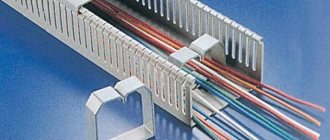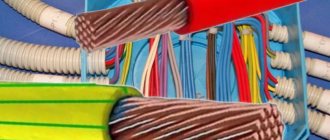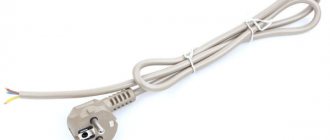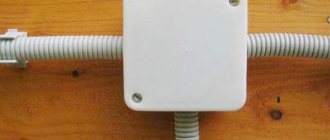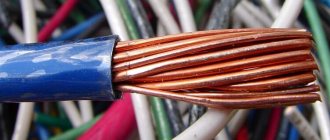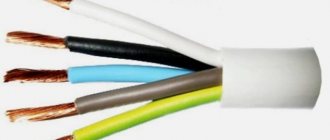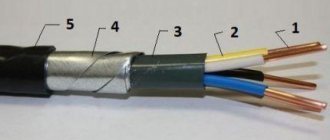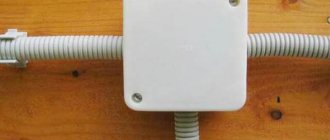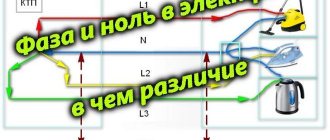The modern industry producing electrical products is ready to offer consumers a huge assortment of cable products. Each type of electrical cable or type of wire is used to solve a specific professional task of electrifying a facility. Any person who decides to install electrical wiring on a personal summer cottage, in his own city apartment or private house will soon understand that copper conductors are most often used for such work and aluminum conductors are much less often used. There are simply no other options, although there are quite a lot of metals with low current resistance.
Why copper and aluminum? Yes, everything is very simple! These are the cheapest non-ferrous metals, optimally suited for the production of wires due to their technical and design characteristics. Of course, it is quite possible to make a cable from gold, but the price of this product will be prohibitive!
Cable products and wires for installation of electrical wiring in residential and other facilities are divided into several types and types: powerful power cables, special self-supporting cables, electrical wires for hidden and open wiring, installation conductors, and so on.
The range of basic characteristics of such electrical products is varied. All cable electrical products are divided into categories not only according to their purpose, but also according to the type of insulating layer, the structure of current-carrying conductors and the metal from which they are made, design features and other parameters. This article will discuss the main types and types, technical parameters and other characteristics of electrical wires and cables that are used when installing electrical wiring and connecting private houses, apartments, cottages and other real estate to power networks.
Attention! Choosing the right electrical cable or wire is a very responsible matter, on which the safety of your property and your own health depends. Therefore, for those who do not want to face such catastrophic events as a short circuit, fire or electric shock, we recommend that you carefully select electrical products that meet the requirements of the Electrical Installation Code (PEU).
Power cables
A powerful cable for power lines is a single-core or multi-core electrical product designed to supply electrical energy to stationary consumers, such as a private house, apartment, cottage or mobile equipment. The power cable connects the main distribution panel or power line to the end user. Regardless of the area of use and technical characteristics, its design consists of the following mandatory elements, which are its basis:
- one or more metal conductors designed to transmit current;
- an insulating layer that provides protection for conductive elements;
- outer sheath, which serves to protect the entire cable structure as a whole.
In addition to these main structural parts of power cable products, they can include a variety of additional elements, such as external belt insulation, a shielding layer, and armor with a cushion under it. The design of the power cable depends on its purpose, scope of use and operating conditions. All these factors are reflected in the color markings and names of the products.
Important! When choosing a power cable, it is necessary to take into account many factors: operating conditions, type and type of installation, as well as compliance with PES standards. This is due to the fact that different brands of cable products have both advantages and disadvantages that must be taken into account when purchasing.
Power cable - marking features
The properties and design features of power cables, as well as the scope of application, are determined by the marking of cable products. Today, there are two types of marking of such products: color or letters. In the Russian Federation, the alphabetic one is used, where each character and its location has a specific meaning. The first character indicates the material of the core and if it is “A”, then it is made of aluminum, and if there is no letter, then it is made of copper. The table below shows the order of marking signs, their letter designation and interpretation.
| Sign number in the power cable marking | Purpose of the symbol | Decoding the symbol |
| 1 | Current-carrying material | A - aluminum No sign - copper |
| 2 | Insulating layer material | B - polyvinyl chloride C - impregnated paper HP - non-flammable rubber P - thermoplastic polyethylene |
| 3 | Type of outer sheath | C - lead alloy A - aluminum alloy O - separate sheath for each core P - polyethylene or polymer B - polyvinyl chloride |
| 4 | Armor protection | B - two steel strips with coating Bn - the same with a non-flammable coating BbG - profiled steel strip K - round galvanized wire P - the same with flat wire |
| 5 | Shielding | E - copper along an insulated conductor Eo - common copper for three conductors d - water-swelling tape ha - polymer-aluminum tape |
| 6 | additional characteristics | ng - off ng LS - off, low smoke emission G - flexible cable |
If any of the elements are missing from the marking, it means that it simply is not on the power cable. Let's say you don't see the armor designation, which means it's missing. The presented letter marking is relevant not only for power cables, but also for other types of wires, with minor changes and additions. Below we will look at the main and most popular brands of power cables produced by the electrical industry.
VVG cable
The main purpose of the VVG power cable is the electrification of facilities with a network voltage of up to 1 thousand volts. This brand is especially popular for indoor electrical wiring. If you refer to the marking table presented above, then VVG is a copper cable with core insulation made of polyvinyl chloride and external insulation in the form of a cambric made of the same material, and the letter “G” indicates that it is flexible. The number of cores of the product can be from two to five. The service life of these products can reach over 30 years.
The VVG power cable is produced in different versions: AVVG - with current-carrying conductors made of pure aluminum, VVGng - in a protective casing made of fire-resistant material, VVGp - a flat-type product and others. The color of the external insulation for most products is black, and each core has its own color scheme, corresponding to the marking according to the standard: yellow with a green stripe for PE conductors, blue or white with a blue stripe for N cores, and absolutely white for phase cores. The VVG power cable almost completely corresponds to its imported analogue, produced according to the foreign DIN standard, the technical parameters of which are presented in the following section.
NYM cable
NYM power cable is used for installation work when laying lighting networks and power electrical networks in both residential and industrial premises. The maximum voltage at which this product can be used should not exceed 660 volts. The cable can be used in open spaces, but it should be taken into account that its insulation is subject to destruction under the influence of sunlight. Therefore, the NYM cable must be protected with a special corrugation or other protective sheath. The main feature of this product is that it is equipped with a special filler inside the outer shell, which ensures complete sealing of the cores.
Unlike the domestically developed VVG power cable, NYM wire is produced only in a round version with solid copper conductors. This fact gives it an advantage in conventional electrical installation, but it is very inconvenient to install it in hidden wiring grooves. In all other respects, the NYM cable is a complete analogue of the VVG. The external and internal insulation of the product is made of heat-resistant PVC (polyvinyl chloride). Its color for the outer sheath is mainly black, and the insulation of the current-carrying conductors has the following colors: black, yellow with a green stripe, brown, as well as gray and blue. In Russian, the product does not have a letter designation.
SIP cable
A SIP power cable is a self-supporting electrical wire with reliable core insulation, the very name of which speaks of its specific properties. Its main feature is that it can withstand large mechanical loads. In addition, the insulating layer of the product is made of stitched polyethylene, which withstands exposure to sunlight and high humidity. Based on these properties, SIP is excellent for installing power lines in open spaces and branches from them for the electrification of various objects, such as residential, as well as small industrial and commercial. This type of cable products is gradually displacing from the market aluminum wires without insulation of grades “A” and “AC”, which were widely used for laying overhead power lines in the recent past.
SIP cable is produced only with cores made of pure aluminum, which do not have an additional common insulating layer. The cross-sectional area of the product conductors can be from 16 to 150 square meters. mm. The marking of this cable is not directly related to the number of current-carrying wires. For example, SIP-1 is a three-core cable, the zero current-carrying conductor of which is also load-bearing. The designated product number encrypts all information about the product. SIP power cable is a rather specific cable product. When installing it, it is necessary to use special fittings: specialized anchor brackets, special clamps for connection, and so on. Without these additional elements it is impossible to carry out installation work.
Cable VBBShv
This product refers to power cables with armor and current-carrying conductors made of copper, which are produced in both monolithic and stranded versions. The cable design can consist of from 1 to 6 current-carrying cores, each of which is enclosed in its own PVC insulation, and on top they are covered with a common sheath of the same material. The cross-sectional area of the conductors ranges from 1.5 to 240 square meters. mm. The main feature of VBBShv is the presence of an armor layer made of two steel strips between the outer protective shell and the current-carrying conductors.
This cable is designed for operation in a wide temperature range from –50 to +50 °C and ambient humidity up to 98%. The insulation of the product is resistant to moisture and aggressive environments. Armored cable VBBShv is intended for installation of electrical networks both underground and outdoors in protective sheaths to eliminate the negative effects of sunlight. VBBShv can be operated in networks with a maximum AC voltage of up to 6 thousand volts.
Attention! At the top of the article, we looked at the most common types of power cables that are present on the modern market. In addition to these products, for the full installation of electrical networks it is necessary to use another type of electrical products, which can be called electrical wires, although this is a purely conditional division. Below we will look at non-power cables, wires and cords intended for electrical wiring and other purposes.
Dimensions and calculation of the cross-section of aluminum and copper
This is the most important point when choosing the right electrical cable. To make an accurate calculation you need to take a few simple steps:
- Calculate the total power of all electrical appliances in the home. This figure will allow you to determine the characteristics of the electric main running from the support to the house.
- Calculate the total power of devices for each room. This allows you to select the desired cross-section of wire that will be laid in each room.
- Route the incoming cable to the VU (ASU) and use the machines to make a wiring diagram for the rooms, taking into account the wire cross-section for each room separately. The cable cross-section based on power is calculated using a special table, which can be found in any electrical reference book. When making calculations, round up and add 20-25% margin. So, for example, a cable with a diameter of about 1.8 mm (section 2.5 mm) will withstand:
- Copper: 21 amps (4.6 kW at 220V)
- Aluminum: 16 amps (3.5 kW at 220V)
This difference clearly shows the advantage of copper electrical cable over aluminum.
Types of electrical wires and cords
For many consumers, the terms cable and wire are synonymous, but this is not entirely true. A cable is a complex electrical product, usually with several layers of insulation and a separate sheath for current-carrying conductors. Electrical wires and cords are much simpler in their design characteristics. Most often they have one layer of insulation, rarely two, and sometimes they are produced without an insulation layer at all. The purpose of these two types of products is also different. The cable is designed to transmit high power current. The wires are used in networks and devices with a voltage of no more than 380 V, although they can withstand higher values.
Among the variety of such products, the following brands have gained the greatest popularity among consumers: PBPP, PBPPg, APUNP, PPV, APV, PVS and ShVVP. These electrical wires are used for various purposes: installation of internal electrical networks, connecting devices and equipment, grounding and in many other cases. Below we will look at the design features and areas of application of these most popular brands of electrical products today.
PBPP wire
This is a flat electrical wire with two or three solid copper cores. The outer protective layer and conductor insulation are made of PVC. The cross-sectional area of the conductors is from 1.5 to 6 square meters. mm. The operating temperature of the product is from –15 to +50 °C with a network voltage of up to 250 V. The electrical wire PBPP (PUNP) is used when installing lighting systems and power outlets. There are modifications of this product: PBPPg and APUNP. The letter “g” in the marking means that this wire is flexible and its current-carrying conductors are multi-wire. The modification with the first letter “A” is a wire with aluminum conductors.
PBPP wire has become very widespread, as it is excellent for connecting lighting, installing electrical sockets and switches, as well as for solving other electrical problems. This product is a truly universal conductor of electric current, which is highly popular due to its excellent quality. PBPP wire is recommended for use when carrying out electrical work in a private house, apartment or country house.
Important! Basically, PBPP brand wires of all modifications are used in home and household networks. They are great for installing indoor wiring, but should not be used as a replacement for power cables. When purchasing these products, be careful, as mislabeling of wires of these brands is quite common!
PPV and APV wire
PPV wire is a flat electrical product with monolithic copper cores in PVC insulation with jumpers between the conductors. The number of current-carrying conductors is two or three with a cross-sectional area from 0.75 to 6.0 square meters. mm. The operating temperature range of the product is from –50 to +70 °C with a network voltage of up to 450 V and air humidity of up to 100%. The wire can be used in lighting networks, as well as in power lines. A modification of this electrical product is the APPV electric wire with aluminum cores.
APV is the most popular aluminum wire with one core in PVC insulation of a round shape with a cross-sectional area from 2.5 to 16 sq. mm for a monolithic core and from 25 to 95 sq. mm for stranded. Moisture-resistant, has increased strength and is resistant to any mechanical loads.
PVS wire
PVA cord is the most popular electrical product designed for connecting lighting equipment, household appliances and other devices that consume electricity to electrical networks. The wire structure is multi-core, containing from 2 to 5 conductive copper conductors. The cores of the product are multi-wire, which gives it excellent flexibility. They are covered with an insulating layer of PVC and placed in a molded sheath of the same material, which hermetically fills the internal volume between the cores.
PVA wire is round with a dense texture. The cross-sectional area of the conductors is from 0.75 to 16 square meters. mm. The mains voltage is up to 380 V, and the operating temperature is from –20 to +40 °C. The shell of the product is usually white, and the insulating layer of the current-carrying conductors is colored. Due to its exceptional flexibility, PVA cord has high resistance to mechanical bending loads. A modification of the product marked PVA U is designed for operation at low temperatures down to –40 °C.
Recommendation! PES standards do not prohibit the use of a PVA cord for laying hidden electrical wiring, organizing grounding and connecting electrical outlets. But if you decide to use this wire specifically for such purposes, then you should know that it cannot be used in open space and, of course, laid in the ground.
ShVVP wire
The SHVVP cord is designed for connecting household appliances and devices to the electrical network. Its main function is a cord for connecting low-power equipment through an outlet to the network. The shell of the product is made of ordinary vinyl, and the insulating layer of each current-carrying core is made of the same material. Current conductors are multi-wire, copper with a cross-sectional area from 0.5 to 0.75 square meters. mm., there are two or three of them. The cord insulation does not have high strength, so it is better not to use it under high loads. The ball screw is flat in design, the shell is absolutely white or black, the insulation of the current-carrying conductors is colored. Operating temperature from –25 to +70 °C.
In addition to connecting low-power household appliances and making simple extension cords, the ShVVP cord is often used in control and automation systems to power low-current circuits. The flexibility of the product is a very important parameter, which allows the wire to be used in a variety of areas. In addition, SHVVP is resistant to aggressive environments and can withstand air humidity up to 98%, which makes it moisture resistant.
Important! The cross-sectional area of wire strands for installing electrical wiring and connecting household appliances depends on the strength of the current flowing through them at maximum load. This value must be calculated and the conductor with the nearest larger cross-sectional area must be selected.
Scope of application
Installation types of cables, which are manufactured according to GOST requirements, have elasticity and polymer insulation strength. The products are used in both the industrial and residential sectors. Cables with a high current rated frequency are used in communication systems in radio electronics. The products have increased flexibility. They can be placed in a complex distribution board. Installation types of cables are used in all types of energy systems. Product selection must be made carefully to avoid modification errors. Take into account the correctness of cables to obtain long, safe operation of power installations.
